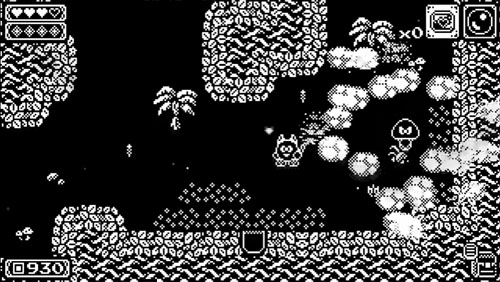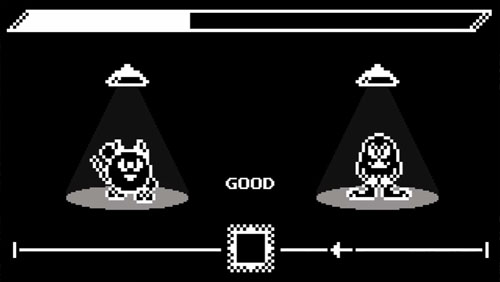A game by Josyan for PC, Switch, Xbox One, and Xbox X/S, originally released in 2023.
UnderDungeon is a dungeon-crawling action adventure featuring chunky 1-bit visuals. You take on the role of Kimuto, who just started working as a delivery driver in the town of Kutopia… which turns out to be a much more difficult job than you might imagine. Kimuto finds himself fighting monsters that have overrun the town, traversing dangerous dungeons, hunting for secrets, and overcoming minigame challenges.As the game begins, Kimuto is having a dream where he – the hero of the day – draws his sword to slay a menacing dragon… but he is soon awakened by the sound of his alarm clock. He hits the snooze button a couple of times, only to realize that he’s going to be late for his job interview if he doesn’t get moving. Fortunately, he manages to get to the office, where he is hired and given a rune that lets him summon a magic sword to defend himself against monsters while making his deliveries.
Kimuto’s first job is to deliver a mop to a scientist so he can clean up a chemical spill, but for some reason the mop is in the sewer. This is in line with the game’s oddball sense of humor, which is prevalent throughout the experience as players interact with numerous NPC’s on their adventure. The sewer acts as a tutorial for players to get accustomed to the controls and learn their movesets, and it features a simple layout with 10 rooms and a boss.
Rather than swinging a sword, Kimuto simply summons the sword for a moment, which causes it to jut out momentarily and then disappear, allowing him to get in one hit on an enemy. But this is far from the only tool at his disposal. Throughout the game, he acquires several new weapons, each of which can be aimed in eight directions.
A bubble allows you to hit enemies at a slightly longer range, although it moves slowly and only two bubbles can be onscreen at a time. In addition, once an enemy is weakened, tossing a bubble causes it to become trapped inside and slowly float away. If it hits any solid object, the bubble pops and the enemy is killed, but it can also hit enemies to cause damage to them. If you run up and kick the enemy-filled bubble, it will fly away quickly in the opposite direction, which can also be used to cause heavy damage to nearby foes.
A hookshot doubles as a weapon and an environmental navigation tool, allowing you to pull yourself across gaps. It’s tough to use as a weapon since it has to fully extend and retract before you can use it again, but it does penetrate enemies, allowing you to hit several in a row. A spinning axe has about the same range as the bubble, but holding the ATTACK button causes it to spin in the air for a few seconds, potentially causing an additional hit… plus you can toss it through walls.
Early into his adventure, Kimuto gets a pair of boots that allow him to sprint with a button press, as well as an upgrade that allows him to perform a swinging sword attack that consumes energy with each use. In fact, each weapon has an upgrade that allows you to perform a secondary attack at the cost of energy. Kimuto has four hearts in his health meter, which are lost in 1-heart increments, along with four units of energy. As you explore, you will discover permanent health and energy extensions.
When you die, you are visited by the Grim Reaper, who will offer to bring you back to life… for a price. You have the option of giving up half of your currency for another chance, or you can sign a contract, which will grant you infinite continues. (In any case, you’ll get some cute quips from the reaper each time you die.) Señor Death doesn’t make it entirely clear what will happen if you accept his contract, but the suggestion is that doing so will prevent you from getting the game’s best ending.
Supplementing your weapons are a number of items, including a bubblegum shield that allows you to absorb a single hit of damage, bombs, mines, on-demand health and energy restoratives, a tonic that increases your attack strength, and an exploding banana. All of your weapons and items may be scrolled through via button presses, but you end up with quite an inventory as the game goes on, which can make it difficult to cycle through to the item you need in a pinch.
A metroidvania map highlights key locations, including treasures, puzzle rooms, and the location of the boss, but the map doesn’t appear until you find the cartographer in each dungeon. Until then, accessing the map screen shows only your location and the relative position of the cartographer (although sometimes the cartographer doesn’t appear until you’ve made some progress in the area). Even the rooms you’ve explored don’t show on the map until you’ve purchased one, and then every room is displayed, except for the hidden ones… which are hinted at with doorways leading to empty space.
Dungeons mostly consist of single screen rooms with pause-and-scroll transitions like The Legend of Zelda, although some rooms are larger and feature scrolling. Heck, a couple of dungeons even have diagonal passageways. Between missions, you’ll return to your home office where you await your next delivery call. You are free to explore the building, discover some secrets, and speak to the people in your office, including a coffee-addicted cat, a friendly robot, and a guy who is taking forever to get out of the bathroom… you can even flush some money down the toilet if you want.
Once you accept a delivery, you are immediately transported to the dungeon, which must be completed before you can return to the office. As you move from room to room, you’ll face a variety of enemies, most of whom die in a couple of hits. Most enemy movements and behaviors are simple, but there are a few little tricks to keep you on your toes, such as enemies that split into smaller ones when killed, enemies that explode into projectiles when killed, some tough fast-movers like bats and dashing cauldrons, and shielded enemies that you need to stomp on before they’re affected by your attacks.
There are some pretty big bosses as well, which require you to stay on the move to avoid their attacks, and get up close to deal damage, given the short range of your weapons. This is a good time to make use of your secondary abilities and items, and it’s not a bad idea to have a shield or health restorative sitting in your active inventory slot in case you become overwhelmed.
By fully exploring the environment, you’ll find ability upgrades, items, caches of money, shopkeepers who offer to sell items, and a casino that lets you risk money for a reward… or buy a drink to restore your health, which is pretty handy given that killed enemies drop plenty of currency, but only rarely drop single-unit health restoratives. While in the casino, you can play roulette and bet on one of three colors, which comes down to luck. You can play slot machines where you must stop the spinning items to line up three of a kind. Or you can play a game of skill in the form of a target shooting gallery, allowing skilled players to rack up as much money as they like.
There are also some occasional minigames to be found in addition to those in the casino, including the obligatory rhythm action battle, as well as an Undertale-style fight where you steer a little heart around to avoid incoming projectiles. You’ll spot some characters from games that inspired this one, including an unofficial appearance by a Link-style adventurer, the protagonist from Minit (another Zelda-inspired 1-bit dungeon crawler), and Darkula from the game of the same name by Locomalito.
There are even some full 3D exploration segments, which you first encounter as you attempt to escape from a jail cell. In these segments, you transform into a mouse and run through dark corridors lined with super-pixelated textures that mimic the rest of the game’s low-rez style. There’s even a bit of head bob as you run, and some treasure chests to find, as you move from mouse hole to mouse hole in search of a key and your equipment. The rest of the area plays out as something of a stealth experience, since you are unarmed and must avoid enemies.
2D CRED
UnderDungeon was developed by Josyan, which is the development label of José Sanz, who previously developed Tamiku and Zeroptian Invasion, and who also worked on Alex Kidd in Miracle World DX. The game’s chippy soundtrack was composed by José Ramón "Bibiki" García, who previously provided music composition, sound design, and audio direction for Alex Kidd in Miracle World DX, and he has composed soundtracks for a number of other games, including Pushy and Pully in Blockland, Burning Knight, and some of Josyan’s previous releases. Graphics and artistic support were provided by Leander.
The game was published by RedDeer.Games, which previously published To Leave, Cyber Protocol, Bit Orchard, and numerous other games.





























0 comments:
Post a Comment